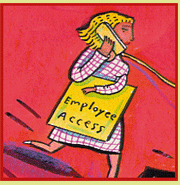|













|
 |
| |
 HERYL
HARDIN HAD A MIGRAINE THAT WOULDN'T QUIT. But when she called The
Emory Clinic to make an appointment, she faced a different headache–the
earliest available datewas more than a month away. “Too long
to wait and to go withoutmedication. ” the Emory University
Hospital nurse recruiter notes. HERYL
HARDIN HAD A MIGRAINE THAT WOULDN'T QUIT. But when she called The
Emory Clinic to make an appointment, she faced a different headache–the
earliest available datewas more than a month away. “Too long
to wait and to go withoutmedication. ” the Emory University
Hospital nurse recruiter notes.
New to her current job, she remembered
learning in orientation about a program that helped Emory employees
coordinate care with Emory health providers.
The Emory Employee Access line, launched
last January, allows employees to call a special phone line for
assistance with scheduling.
“I was amazed at how well it
worked,” Hardin says. “I called the telephone line and
spoke with a nurse at HealthConnection, who called several people
and kept me informed of the process while she was working on an
appointment.
|
|
 |
| |
The
access line was the earliest and most visible step in a more than
yearlong effort to encourage more faculty and staff to seek care
within Emory’s own health system.
The process is a natural effort to
extend the benefits of Emory’s progress to the very people
who make it possible, says Donald Brunn, The Emory Clinic’s
chief operating officer. The clinic has seen a tremendous growth
in capacity in the past two years and is making a concerted effort
to ensure that members of its own community share the rewards.
“We have seen impressive growth
in the number and depth of our physician faculty, particularly with
the development of the Winship Cancer Institute, a new orthopaedic
and spine center facility, and new outpatient diagnostic capabilities
in digestive health and radiology. Our revenues have increased 10%
to 12% each of the past three years,” he says. “Around
this time last year, however, I noticed that we had been doing a great deal of outreach
and communication to the public about the growth and the opportunities
for care here, but we had done very little outreach to the Emory
community. We needed to reach out to our Emory family, and we needed
to be focused about it.”
however, I noticed that we had been doing a great deal of outreach
and communication to the public about the growth and the opportunities
for care here, but we had done very little outreach to the Emory
community. We needed to reach out to our Emory family, and we needed
to be focused about it.”
Since learning in late 2003 that Emory
Healthcare (EHC) was providing care to Emory employees only about
half the time that it could, administrators stepped up efforts to
improve access—clinic section schedulers were instructed to
give Emory employees top priority, the access line assistants paved
the way to faster appointments, and an educational campaign touted
the state-of-the-art care available.

In September 2003, two Emory Healthcare marketing surveys revealed
that concerns about confidentiality and difficulty in obtaining
timely appointments were key reasons employees sought care elsewhere.
In an initial survey of 3,743 health
system and university employees, respondents ranked Emory either
“better than” or “as good as” other health
care providers on all criteria except ease of scheduling and appointment
availability. In the last category, 23% ranked Emory as “much
worse” than other providers.
A second survey of former participants
in the Woodruff Leadership Academy found that 38% were “very
concerned” about confidentiality of their health information
when receiving care from their health care provider, while 33% reported
that they were “somewhat concerned” and 29% were not
concerned.
Almost 16% of respondents said that
confidentiality concerns had been a factor in their decision to
seek care from non–Emory providers.
The information gleaned from the surveys
told administrators that they must aggressively address scheduling
difficulties and that they needed to do a better job of educating
employees about the health information privacy protections that
were in place.
Respondents in the first survey overwhelmingly
indicated that they would use a program like the employee access
line and that it would influence their decision to use Emory providers,
says Una Newman, director of marketing for EHC. “So, we developed
dedicated phone numbers for each clinic section for employees to
use for making appointments. But we didn’t stop there. We
also created a backup advocacy line, which could be used if employees
felt that they did not receive a desired response from a clinical
section.”
The issue of confidentiality, however,
was trickier. Health system employees
are often faced with a conundrum. If they use their employer as
their health care provider, will their boss end up with information
about their medical condition? And will their co-workers know when
they go to the doctor?
“We wanted to find out whether
the concerns were an issue of ‘Will someone see me at the
doctor’s office?’” she notes. “Or, were
they concerned about the true confidentiality of their medical information?
Could someone get to a computer and look them up?”
Responses to the second survey indicated
that while some people just do not want to receive medical care
from their employer, most of the people concerned with privacy were
worried about the issue of unauthorized access to their medical
records, a more serious problem, she says.
“We care a great deal about
that concern,” Newman says. “We cannot overstate how
seriously we take the issue of privacy of medical information. We
have strict measures in place to protect patient confidentiality.
We will fire people who violate those policies.”
The clinic has risen to the challenge
of addressing the scheduling issue, says Brunn.
“Many people have long-held
beliefs that getting an appointment at The Emory Clinic in a timely
way takes having a special connection or a physician’s referral. This
is no longer true,” he notes. “We have the support of
each department chair to make certain that Emory employees have
top priority access to their clinical areas. We are determined to
get out the message that The Emory Clinic is open for Emory business
and that we want to care for them. Emory faculty members, staff,
or their families go to the head of the line when they identify
themselves as part of the Emory organization.”
having a special connection or a physician’s referral. This
is no longer true,” he notes. “We have the support of
each department chair to make certain that Emory employees have
top priority access to their clinical areas. We are determined to
get out the message that The Emory Clinic is open for Emory business
and that we want to care for them. Emory faculty members, staff,
or their families go to the head of the line when they identify
themselves as part of the Emory organization.”
There are limits, Brunn admits.
“There is no way to guarantee
access to specific providersat specific times of day or days of
week without expecting a long delay. And some of our senior faculty
are no longer accepting new patients,” he explains. “But
our schedulers are trained to offer next-available appointment access
with any one of numerous faculty in any given specialty area, and
all of our faculty are of the highest quality.”
To provide top-quality care to the
community at large, Emory should first ensure that its own employees
receive the best treatment, Brunn emphasizes. “To the extent
that we’re able to do well by employees, we’ll be able
to do even better by all the rest of the patients.”
Emory employees serve as an important
bellwether for how well the health system serves all of its patients,
Newman agrees, noting that the employee surveys provided valuable
information about how often respondents received recommended diagnostic
and screening tests, such as mammography.
“Employees are a good audience
in terms of our ability to ask questions about their care,”
she says. “The answers we get help improve care for everyone.”

The issue is about more than just self-improvement, however. Stemming
the flow of health care dollars tocompeting providers is also important,
notes John Fox, EHC’s CEO.Emory University and Emory Healthcare
both self-fund their health plans, he explains. Unlike some companies,
which pay premiums to outside insurers to cover the cost of health
care for their employees, Emory contracts with insurance companies
only for administrative services, such as recordkeeping and filing
of claims. The costs of employee health care are paid directly by
the university and EHC. It costs significantly more money to pay
for care provided outside their network.
“You have to consider that,
for each procedure or service, there are fixed and variable costs,”
Fox explains. “If we pay $2,000 for someone to have an MRI
done at Piedmont, that charge includes both the costs of that individual
patient encounter, plus a percentage of the cost of Piedmont’s
purchase and maintenance of the MRI equipment.”
The same MRI performed at Emory would
cost the university and EHC plans about half as much because EHC
has already absorbed the fixed costs of the equipment.
Although employees are sometimes under
the impression that added expenses are absorbed by some “big
insurance company,” the fact is that Emory writes the check
for all health care provided to employees, Fox says. Extra money
spent on outside care is money that is unavailable to support research
and new technology here.
Claims data for university and health
system employees for 2003 indicate that the total amount of care
from non-Emory providers that could have been provided by Emory
totaled $22 million.
“We are in a common situation
for major health systems in that we are both a health care provider
and
employer providing health coverage. We both provide it and fund
it for our employees,” Fox notes.
In the face of skyrocketing health
care costs, Emory is going to have to become more prudent in the
use of its resources, Fox says.
In the coming year, the university
and EHC expect to spend $17 million more on employee health care
than they did last year.
They are not alone.
The rising prices of new pharmaceuticals
and new medical technology are pushing the costs of employer-sponsored
health coverage through the roof nationwide. Many employers are
shifting more of the payment burden to their employees, dropping
health coverage altogether, or using more temporary workers instead
of filling permanent positions.
No such plans are in the works at
Emory, says Fox. For this fiscal year, the employee portion of health
plan premiums remained the same as last year. The health plans did
increase the co-pays that employees pay for seeing out-of-network
providers.
“We are committed to providing
employees high-quality
medical benefits while keeping costs affordable,” says Fox.
“In fact, we did not increase full-time employees’ health
care premiums in 2005—despite national trends to the contrary.”
However, Emory may be unable to hold
the line for long.
The total cost of employee health
care for 2003 was just over $77 million, more than double what it
was five years ago. If costs continue to increase at the current
rate or faster, the current health plans could become an untenable
burden.
“Emory and Emory Healthcare
are close to spending $100 million annually on health care, and
that is not sustainable,” says Fox.
The solution lies not in simply cutting
costs wherever possible but in ensuring that Emory employees get
the highest quality care delivered in the most efficient manner,
he adds.
For example, pharmaceuticals are one
of the biggest expenses of any organization’s health plan
and one of the fastest growing. Last year, Emory implemented a new
pharmacy plan design in an attempt to control the 16% to 20% annual
cost increases in prescription drugs. Employees are charged lower
co-pays for generic drugs and brand name drugs offering equal or
greater therapeutic value and cost-effectiveness compared with other
drugs in the same drug category.
“The recent increase in direct-to-consumer
pharmaceutical marketing has led to patients seeking brand-name
drugs that often do not work as well as other drugs for their condition,”
Fox notes.
Emory must also do more to encourage
employees to use Emory providers whenever possible, he adds, acknowledging
that the health system has some adjustments to make on its own.
At a time when the entire country
is struggling with how to provide and afford good health care, Emory
has the potential to be a pioneer both on the provider and payer
side by improving quality and efficiency and effectively reining
in expenses.
“We have to be competitive,
and we have to offer employees a reasonable network,” he notes.
“If you live in Henry County and you need a general pediatrician,
you can’t come up here to take your child to the doctor, and
we have to do something about things like that. We are also going
to have to get much more serious about controlling health care costs.
Our goal is to be a model of providing affordable, high-quality,
efficient health care for everyone.” 
Catherine
Harris is the editor of Momentum.
|
|
| |
| |
|
|
| |
Getting
an appointment sooner
Emory
Employee Access is a two-tiered process designed to
ease appointment scheduling for faculty and staff of
the university and health system.
Employees start with the
traditional route, by calling section schedulers. However,
they should also be sure to identify themselves as an
Emory employee at this point. This will ensure they
are given priority in scheduling appointments.
If the scheduled appointment
time is still unsatisfactory, the employee should proceed
to the second step and call the employee access line (404-778-EVIP
[3487]). A nurse there will help coordinate a visit
with an appropriate Emory provider.
second step and call the employee access line (404-778-EVIP
[3487]). A nurse there will help coordinate a visit
with an appropriate Emory provider.
In most cases, an earlier
appointment can be arranged.
An analysis of the calls
to the EVIP line from the first two quarters of operation
indicated that of the 18 times that employees called
requesting an earlier appointment, schedulers were able
to accommodate that request 17 times. During the first
two quarters of operation, the line received 155 total
calls, with most of the callers requesting basic information
about providers or seeking to establish a new primary
care physician.
In addition to using the
EVIP line, employees can find a list of physicians by
specialty by visiting Emory Healthcare’s website
(www.emoryhealthcare.org)
or by calling Emory HealthConnection (404-778-7777 or
1-800-75-EMORY). |
|
| |
|
|
|
|
|
| |
|
|
| |
|
|
| |
|
|
| |
|
|
| |
|
|
|
|
|

